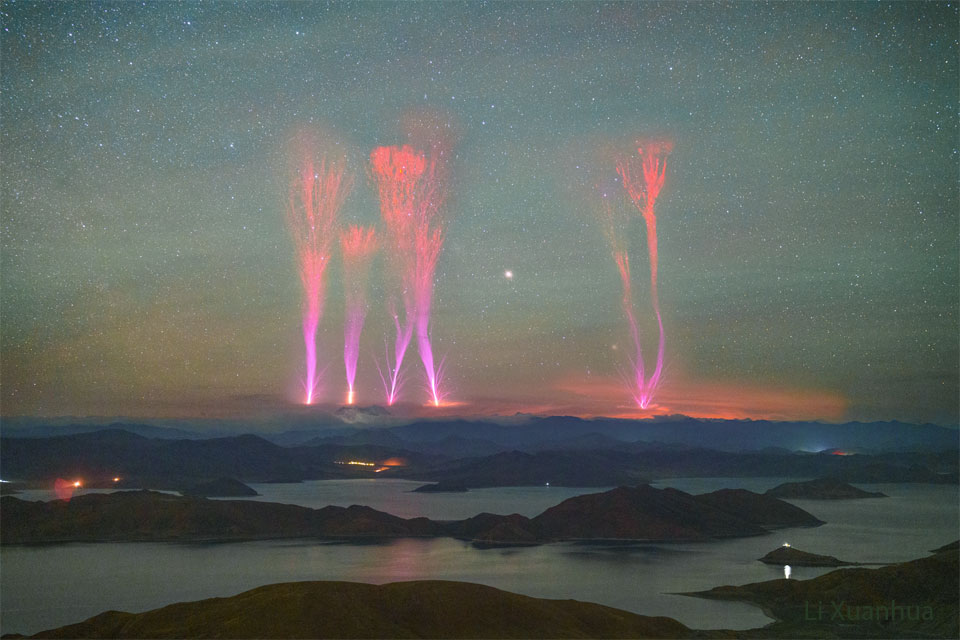Nombre total de pages vues
19/06/2024
SANTé/MEDECINE - L'anatomie du coeur humain - Coupe dans le ventricule gauche
ASTRONOMY - NGC 6188: Dragons of Ara
2024 June 19
Image Credit & Copyright: Carlos Taylor
Explanation: Do dragons fight on the altar of the sky? Although it might appear that way, these dragons are illusions made of thin gas and dust. The emission nebula NGC 6188, home to the glowing clouds, is found about 4,000 light years away near the edge of a large molecular cloud, unseen at visible wavelengths, in the southern constellation Ara (the Altar). Massive, young stars of the embedded Ara OB1 association were formed in that region only a few million years ago, sculpting the dark shapes and powering the nebular glow with stellar winds and intense ultraviolet radiation. The recent star formation itself was likely triggered by winds and supernova explosions from previous generations of massive stars, that swept up and compressed the molecular gas. This impressively detailed image spans over 2 degrees (four full Moons), corresponding to over 150 light years at the estimated distance of NGC 6188.
18/06/2024
SANTé/MEDECINE - L'anatomie du coeur humain
SANTé/MEDECINE - L'immortalité pour bientôt - L'entropie
ASTRONOMY - Gigantic Jets over Himalayan Mountains
2024 June 18
Image Credit & Copyright: Li Xuanhua
Explanation: Yes, but can your thunderstorm do this? Pictured here are gigantic jets shooting up from a thunderstorm last week toward the Himalayan Mountains in China and Bhutan. The composite image captured four long jets that occurred only minutes apart. Gigantic jets, documented only in this century, are a type of lightning discharge that occurs between some thunderstorms and the Earth's ionosphere high above them. They are an unusual type of lightning that is much different from regular cloud-to-cloud and cloud-to-ground lightning. The bottoms of gigantic jets appear similar to a cloud-to-above strike called blue jets, while the tops appear similar to upper-atmosphere red sprites. Although the mechanism and trigger that cause gigantic jets remains a topic of research, it is clear that the jets reduce charge imbalance between different parts of Earth's atmosphere. A good way to look for gigantic jets is to watch a powerful but distant thunderstorm from a clear location.
17/06/2024
ASTRONOMY - Ou4: The Giant Squid Nebula
2024 June 17
Image Credit & Copyright: Alex Linde
Explanation: Squids on Earth aren't this big. This mysterious squid-like cosmic cloud spans nearly three full moons on planet Earth's sky. Discovered in 2011 by French astro-imager Nicolas Outters, the Squid Nebula's bipolar shape is distinguished here by the telltale blue emission from doubly ionized oxygen atoms. Though apparently surrounded by the reddish hydrogen emission region Sh2-129, the true distance and nature of the Squid Nebula have been difficult to determine. Still, one investigation suggests Ou4 really does lie within Sh2-129 some 2,300 light-years away. Consistent with that scenario, the cosmic squid would represent a spectacular outflow of material driven by a triple system of hot, massive stars, cataloged as HR8119, seen near the center of the nebula. If so, this truly giant squid nebula would physically be over 50 light-years across.
16/06/2024
SANTé/MEDECINE - L'immortalité pour bientôt - La possibilité de vivre éternellement
ASTRONOMY - Animation: Black Hole Destroys Star
2024 June 16
Video Illustration Credit: DESY, Science Communication Lab
Explanation: What happens if a star gets too close to a black hole? The black hole can rip it apart -- but how? It's not the high gravitational attraction itself that's the problem -- it's the difference in gravitational pull across the star that creates the destruction. In the featured animated video illustrating this disintegration, you first see a star approaching the black hole. Increasing in orbital speed, the star's outer atmosphere is ripped away during closest approach. Much of the star's atmosphere disperses into deep space, but some continues to orbit the black hole and forms an accretion disk. The animation then takes you into the accretion disk while looking toward the black hole. Including the strange visual effects of gravitational lensing, you can even see the far side of the disk. Finally, you look along one of the jets being expelled along the spin axis. Theoretical models indicate that these jets not only expel energetic gas, but also create energetic neutrinos -- one of which may have been seen recently on Earth.
ASTRONOMIE - LES PLUS BEAUX ASTRES DE LA VOIE LACTéE - Antiope : l’astéroïde double
Découvert en 1866, (90) Antiope est un astéroïde qui possède la caractéristique d'être binaire . Cela signifie qu'il est constitué ...

-
2021 May 11 Lightning and Orion Beyond Uluru Image Credit & Copyright: Park Liu Explanation: What's happening behind Uluru? A Un...
-
Extraordinary Solar Halos Image Credit & Copyright : Magnus Edback Explanation: Welcome to the December Solstice, the first...






